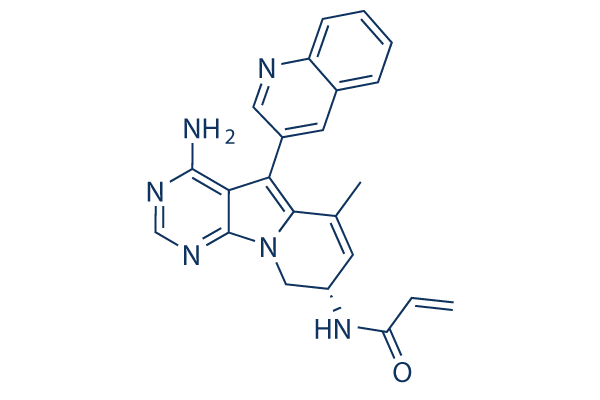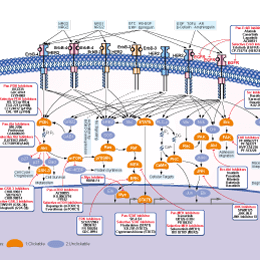
- Bioactive Compounds
- By Signaling Pathways
- PI3K/Akt/mTOR
- Epigenetics
- Methylation
- Immunology & Inflammation
- Protein Tyrosine Kinase
- Angiogenesis
- Apoptosis
- Autophagy
- ER stress & UPR
- JAK/STAT
- MAPK
- Cytoskeletal Signaling
- Cell Cycle
- TGF-beta/Smad
- DNA Damage/DNA Repair
- Compound Libraries
- Popular Compound Libraries
- Customize Library
- Clinical and FDA-approved Related
- Bioactive Compound Libraries
- Inhibitor Related
- Natural Product Related
- Metabolism Related
- Cell Death Related
- By Signaling Pathway
- By Disease
- Anti-infection and Antiviral Related
- Neuronal and Immunology Related
- Fragment and Covalent Related
- FDA-approved Drug Library
- FDA-approved & Passed Phase I Drug Library
- Preclinical/Clinical Compound Library
- Bioactive Compound Library-I
- Bioactive Compound Library-Ⅱ
- Kinase Inhibitor Library
- Express-Pick Library
- Natural Product Library
- Human Endogenous Metabolite Compound Library
- Alkaloid Compound LibraryNew
- Angiogenesis Related compound Library
- Anti-Aging Compound Library
- Anti-alzheimer Disease Compound Library
- Antibiotics compound Library
- Anti-cancer Compound Library
- Anti-cancer Compound Library-Ⅱ
- Anti-cancer Metabolism Compound Library
- Anti-Cardiovascular Disease Compound Library
- Anti-diabetic Compound Library
- Anti-infection Compound Library
- Antioxidant Compound Library
- Anti-parasitic Compound Library
- Antiviral Compound Library
- Apoptosis Compound Library
- Autophagy Compound Library
- Calcium Channel Blocker LibraryNew
- Cambridge Cancer Compound Library
- Carbohydrate Metabolism Compound LibraryNew
- Cell Cycle compound library
- CNS-Penetrant Compound Library
- Covalent Inhibitor Library
- Cytokine Inhibitor LibraryNew
- Cytoskeletal Signaling Pathway Compound Library
- DNA Damage/DNA Repair compound Library
- Drug-like Compound Library
- Endoplasmic Reticulum Stress Compound Library
- Epigenetics Compound Library
- Exosome Secretion Related Compound LibraryNew
- FDA-approved Anticancer Drug LibraryNew
- Ferroptosis Compound Library
- Flavonoid Compound Library
- Fragment Library
- Glutamine Metabolism Compound Library
- Glycolysis Compound Library
- GPCR Compound Library
- Gut Microbial Metabolite Library
- HIF-1 Signaling Pathway Compound Library
- Highly Selective Inhibitor Library
- Histone modification compound library
- HTS Library for Drug Discovery
- Human Hormone Related Compound LibraryNew
- Human Transcription Factor Compound LibraryNew
- Immunology/Inflammation Compound Library
- Inhibitor Library
- Ion Channel Ligand Library
- JAK/STAT compound library
- Lipid Metabolism Compound LibraryNew
- Macrocyclic Compound Library
- MAPK Inhibitor Library
- Medicine Food Homology Compound Library
- Metabolism Compound Library
- Methylation Compound Library
- Mouse Metabolite Compound LibraryNew
- Natural Organic Compound Library
- Neuronal Signaling Compound Library
- NF-κB Signaling Compound Library
- Nucleoside Analogue Library
- Obesity Compound Library
- Oxidative Stress Compound LibraryNew
- Plant Extract Library
- Phenotypic Screening Library
- PI3K/Akt Inhibitor Library
- Protease Inhibitor Library
- Protein-protein Interaction Inhibitor Library
- Pyroptosis Compound Library
- Small Molecule Immuno-Oncology Compound Library
- Mitochondria-Targeted Compound LibraryNew
- Stem Cell Differentiation Compound LibraryNew
- Stem Cell Signaling Compound Library
- Natural Phenol Compound LibraryNew
- Natural Terpenoid Compound LibraryNew
- TGF-beta/Smad compound library
- Traditional Chinese Medicine Library
- Tyrosine Kinase Inhibitor Library
- Ubiquitination Compound Library
-
Cherry Picking
You can personalize your library with chemicals from within Selleck's inventory. Build the right library for your research endeavors by choosing from compounds in all of our available libraries.
Please contact us at info@selleckchem.com to customize your library.
You could select:
- Antibodies
- Bioreagents
- qPCR
- 2x SYBR Green qPCR Master Mix
- 2x SYBR Green qPCR Master Mix(Low ROX)
- 2x SYBR Green qPCR Master Mix(High ROX)
- Protein Assay
- Protein A/G Magnetic Beads for IP
- Anti-Flag magnetic beads
- Anti-Flag Affinity Gel
- Anti-Myc magnetic beads
- Anti-HA magnetic beads
- Poly DYKDDDDK Tag Peptide lyophilized powder
- Protease Inhibitor Cocktail
- Protease Inhibitor Cocktail (EDTA-Free, 100X in DMSO)
- Phosphatase Inhibitor Cocktail (2 Tubes, 100X)
- Cell Biology
- Cell Counting Kit-8 (CCK-8)
- Animal Experiment
- Mouse Direct PCR Kit (For Genotyping)
- New Products
- Contact Us
zipalertinib (TAS6417)
EGFR inhibitor
research use only
zipalertinib (TAS6417) is a novel EGFR inhibitor that targets EGFR exon 20 insertion mutations while sparing wild-type (WT) EGFR. IC50 values ranges from 1.1 ± 0.1 to 8.0 ± 1.1 nmol/L.

zipalertinib (TAS6417) Chemical Structure
Molecular Weight: 396.44
Purity & Quality Control
Batch:
S881401
DMSO]79 mg/mL]false]Ethanol]79 mg/mL]false]Water]Insoluble]false
Purity:
99.86%
99.86
zipalertinib (TAS6417) Related Products
| Related Targets | EGFR/ErbB1 HER2/ErbB2 ErbB3 ErbB4 mutant EGFR | Click to Expand |
|---|---|---|
| Related Products | AG-490 AG-1478 Canertinib (CI-1033) Rociletinib (CO-1686) WZ4002 Genistein Poziotinib PD153035 PD153035 HCl Allitinib tosylate AEE788 (NVP-AEE788) Pelitinib (EKB-569) Canertinib dihydrochloride Varlitinib Icotinib (BPI-2009H) Nazartinib (EGF816) NSC228155 PD168393 Olmutinib (BI 1482694) Zorifertinib (AZD3759) | Click to Expand |
| Related Compound Libraries | Tyrosine Kinase Inhibitor Library PI3K/Akt Inhibitor Library Angiogenesis Related compound Library HIF-1 Signaling Pathway Compound Library FDA-approved Anticancer Drug Library | Click to Expand |
Signaling Pathway
Mechanism of Action
| Description | zipalertinib (TAS6417) is a novel EGFR inhibitor that targets EGFR exon 20 insertion mutations while sparing wild-type (WT) EGFR. IC50 values ranges from 1.1 ± 0.1 to 8.0 ± 1.1 nmol/L. | |||||||||||
|---|---|---|---|---|---|---|---|---|---|---|---|---|
| Targets |
|
In vitro |
||||
| In vitro | Of the 255 kinases tested, TAS6417 inhibits 25 kinases other than EGFR with IC50 values less than 1,000 nmol/L, which was 100 times higher than its IC50 value against WT EGFR. It inhibits only six kinases containing TXK, BMX, HER4, TEC, BTK, and JAK3, with IC50 values less than 10 times that against WT EGFR. TAS6417 inhibits proliferation of Ba/F3 cells driven by various EGFR exon 20 insertion mutations, with IC50 values ranging from 5.05 ± 1.33 nmol/L to 150 ± 53 nmol/L. It also suppresses the growth of cells expressing exon 20 insertion mutations of the EGFR gene, with a GI50 value of 86.5 ± 28.5 nmol/L for LXF 2478L cells and 45.4 ± 2.6 nmol/L for NCI-H1975 EGFR D770_N771insSVD cells. TAS6417 has no effect on EGFR-independent proliferation in NCI-H23 or NCI-H460 cells[1]. |
|||
|---|---|---|---|---|
| Cell Research | Cell lines | LXF 2478L cells and NCI-H1975 EGFR D770_N771insSVD cells | ||
| Concentrations | 0-1 μM | |||
| Incubation Time | 6 and 24 hours | |||
| Method | The cells are cultured with TAS6417 or afatinib and harvested 6 and 24 hours after treatment. Phosphorylation of EGFR-Tyr1068, AKT-Ser473, and ERK1/2-Thr202/Tyr204 and expression of BIM and cleaved PARP are determined using immunoblotting analysis. |
|||
In Vivo |
||
| In vivo | TAS6417 causes persistent tumor regression in vivo in EGFR exon 20 insertion-driven tumor models. The tumor regression occurrs quickly after TAS6417 treatment and persists during the treatment period. Pharmacokinetic analysis reveals that the plasma concentration of TAS6417, administered at 50 and 100 mg/kg to mice, decreases rapidly in the first 4 hours. In contrast, although the effective doses in the rat model exhibit lower maximum plasma concentration (Cmax) values than those in the mouse model, the plasma concentrations tend to be more persistent, lasting up to 8 hours. TAS6417 inhibits mutant EGFR in tumors but not WT EGFR in skin tissues. It prolongs survival of animals bearing lung cancer[1]. |
|
|---|---|---|
| Animal Research | Animal Models | BALB/cAJcl-nu/nu nude mice with intrapulmonary NCI-H1975 EGFR D770_N771insSVD xenografts |
| Dosages | 100 mg/kg/day and 200 mg/kg/day | |
| Administration | oral | |
References |
|
Chemical Information
| Molecular Weight | 396.44 | Formula | C23H20N6O |
| CAS No. | 1661854-97-2 | SDF | -- |
| Synonyms | CLN-081, TPC-064 | ||
| Smiles | CC1=CC(CN2C1=C(C3=C(N=CN=C32)N)C4=CC5=CC=CC=C5N=C4)NC(=O)C=C | ||
Storage and Stability
| Storage (From the date of receipt) | 3 years -20°C powder | ||
|
In vitro |
DMSO : 79 mg/mL ( (199.27 mM) Moisture-absorbing DMSO reduces solubility. Please use fresh DMSO.) Ethanol : 79 mg/mL Water : Insoluble |
Molecular Weight Calculator |
|
In vivo Add solvents to the product individually and in order. |
In vivo Formulation Calculator |
|||||
Preparing Stock Solutions
Molarity Calculator
In vivo Formulation Calculator (Clear solution)
Step 1: Enter information below (Recommended: An additional animal making an allowance for loss during the experiment)
mg/kg
g
μL
Step 2: Enter the in vivo formulation (This is only the calculator, not formulation. Please contact us first if there is no in vivo formulation at the solubility Section.)
% DMSO
%
% Tween 80
% ddH2O
%DMSO
%
Calculation results:
Working concentration: mg/ml;
Method for preparing DMSO master liquid: mg drug pre-dissolved in μL DMSO ( Master liquid concentration mg/mL, Please contact us first if the concentration exceeds the DMSO solubility of the batch of drug. )
Method for preparing in vivo formulation: Take μL DMSO master liquid, next addμL PEG300, mix and clarify, next addμL Tween 80, mix and clarify, next add μL ddH2O, mix and clarify.
Method for preparing in vivo formulation: Take μL DMSO master liquid, next add μL Corn oil, mix and clarify.
Note: 1. Please make sure the liquid is clear before adding the next solvent.
2. Be sure to add the solvent(s) in order. You must ensure that the solution obtained, in the previous addition, is a clear solution before proceeding to add the next solvent. Physical methods such
as vortex, ultrasound or hot water bath can be used to aid dissolving.
Tech Support
Answers to questions you may have can be found in the inhibitor handling instructions. Topics include how to prepare stock solutions, how to store inhibitors, and issues that need special attention for cell-based assays and animal experiments.
Tel: +1-832-582-8158 Ext:3
If you have any other enquiries, please leave a message.
* Indicates a Required Field






































